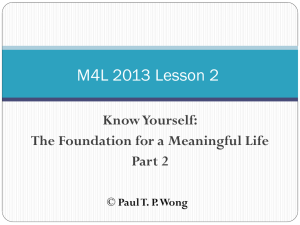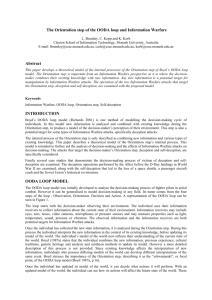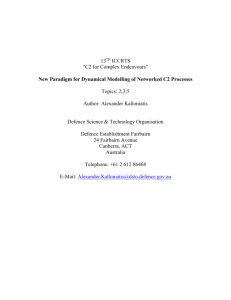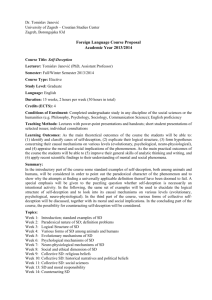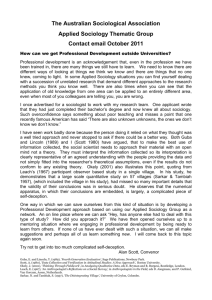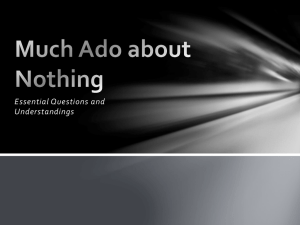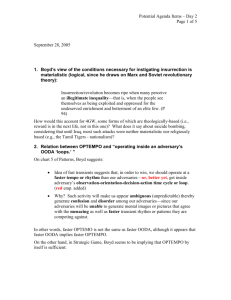OODA-Loop-BKK-IWC7-2.. - Clayton
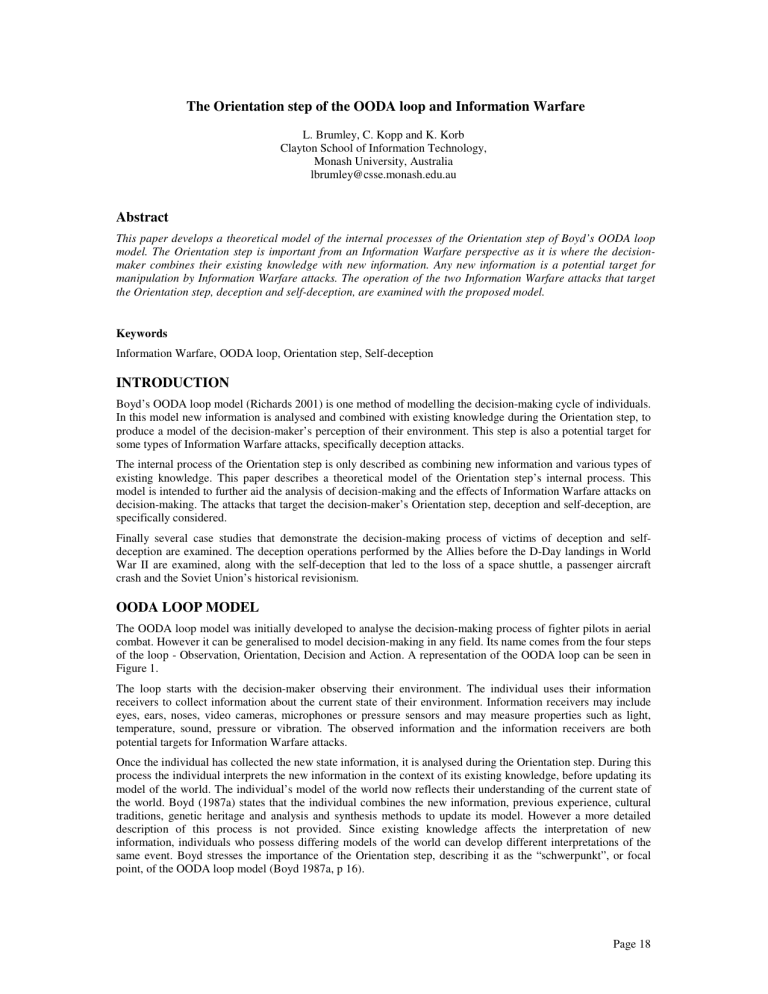
The Orientation step of the OODA loop and Information Warfare
L. Brumley, C. Kopp and K. Korb
Clayton School of Information Technology,
Monash University, Australia lbrumley@csse.monash.edu.au
Abstract
This paper develops a theoretical model of the internal processes of the Orientation step of Boyd’s OODA loop model. The Orientation step is important from an Information Warfare perspective as it is where the decisionmaker combines their existing knowledge with new information. Any new information is a potential target for manipulation by Information Warfare attacks. The operation of the two Information Warfare attacks that target the Orientation step, deception and self-deception, are examined with the proposed model.
Keywords
Information Warfare, OODA loop, Orientation step, Self-deception
INTRODUCTION
Boyd’s OODA loop model (Richards 2001) is one method of modelling the decision-making cycle of individuals.
In this model new information is analysed and combined with existing knowledge during the Orientation step, to produce a model of the decision-maker’s perception of their environment. This step is also a potential target for some types of Information Warfare attacks, specifically deception attacks.
The internal process of the Orientation step is only described as combining new information and various types of existing knowledge. This paper describes a theoretical model of the Orientation step’s internal process. This model is intended to further aid the analysis of decision-making and the effects of Information Warfare attacks on decision-making. The attacks that target the decision-maker’s Orientation step, deception and self-deception, are specifically considered.
Finally several case studies that demonstrate the decision-making process of victims of deception and selfdeception are examined. The deception operations performed by the Allies before the D-Day landings in World
War II are examined, along with the self-deception that led to the loss of a space shuttle, a passenger aircraft crash and the Soviet Union’s historical revisionism.
OODA LOOP MODEL
The OODA loop model was initially developed to analyse the decision-making process of fighter pilots in aerial combat. However it can be generalised to model decision-making in any field. Its name comes from the four steps of the loop - Observation, Orientation, Decision and Action. A representation of the OODA loop can be seen in
Figure 1.
The loop starts with the decision-maker observing their environment. The individual uses their information receivers to collect information about the current state of their environment. Information receivers may include eyes, ears, noses, video cameras, microphones or pressure sensors and may measure properties such as light, temperature, sound, pressure or vibration. The observed information and the information receivers are both potential targets for Information Warfare attacks.
Once the individual has collected the new state information, it is analysed during the Orientation step. During this process the individual interprets the new information in the context of its existing knowledge, before updating its model of the world. The individual’s model of the world now reflects their understanding of the current state of the world. Boyd (1987a) states that the individual combines the new information, previous experience, cultural traditions, genetic heritage and analysis and synthesis methods to update its model. However a more detailed description of this process is not provided. Since existing knowledge affects the interpretation of new information, individuals who possess differing models of the world can develop different interpretations of the same event. Boyd stresses the importance of the Orientation step, describing it as the “schwerpunkt”, or focal point, of the OODA loop model (Boyd 1987a, p 16).
Page 18
Once the individual has updated its model of the world, it can decide what actions it will perform. With an updated model of the world, the individual can see how its actions will affect the future state of the world. These changes can be assessed in terms of their benefit and penalty to the individual. If the individual is using a rational decision-making method, then it will choose actions that maximise its expected benefits and minimise its expected penalties. The OODA loop model does not restrict the individual’s decision-making methods in any way.
Gathered
Information
Observation Orientation
Worl
Perceived
Model of the world
Performed
Actions
Action Decision
Figure 1: Boyd’s OODA loop model
Finally during the Action step the individual performs its chosen actions. Actions typically affect the state of the world, by manipulating objects in the world or communicating information to others. Changes to the state of the world are observable by others. Individuals may also partially or completely fail to perform their intended actions correctly.
The OODA loop models a feedback loop between the decision-maker and its environment. Actions alter the state of the world, which is then perceived during future iterations of the loop. Advantages over opponents can be gained by “operating inside their OODA loop” - deciding and acting faster than they can in order to appear ambiguous and unpredictable (Boyd 1987b, p 44, 47).
EXPANDING THE ORIENTATION STEP
The Orientation step is described as a ‘melting pot’ where new information and existing knowledge are somehow combined to produce an updated model of the world. This process is not explained in any detail, possibly as it would reduce the generality of the OODA loop model. The main elements that are combined during this step are the new information, previous experience, cultural traditions, genetic heritage and analysis and synthesis methods of the individual (Boyd 1987a, Richards 2001).
It is proposed that there are four main tasks that an individual performs during its Orientation step. The first task is recognising previously observed objects, events and relationships, which allows an individual to retrieve existing information about these elements. The second is to analyse the new information with previously known processing methods to produce an updated model of the world. The model of the world stores the individual’s perception of the past, present and future state of its environment. The individual’s third task is to determine whether it is meeting its aims and to develop new aims, based on the predicted future state of the world. An individual’s aims are specific outcomes that the individual wishes to occur, which direct the individual’s current and future behaviour. The individual’s fourth task is to determine what options it may perform and how these options will affect its environment.
From this determination of an individual’s tasks during the Orientation step, it is proposed that the Orientation step can be partitioned into four sub-steps: Identification, Interpretation, Aims Derivation and Options
Generation (Figure 2). This model also shows the internal information channels between the individual’s stored model of the world and the sub-steps that access this information. All of the sub-steps are capable of both retrieving information from and placing information into the model of the world.
Page 19
The Orientation step starts with an Identification sub-step. Here the newly gathered information is compared to stored information, allowing known objects and events to be recognised. If an element is not recognised then a placeholder entry can be created for it, which will have associated information linked to it as the individual learns about the element. A recognised element is something that the individual has previously observed and can recognise. Any existing knowledge for this element can be used in the analysis. In this step the individual is essentially asking itself ‘What is it?’ for each of the various elements it has perceived in its environment.
Next is the Interpretation sub-step, where the identified and unidentified objects are compared to the existing world model to determine how the world has changed since the last loop iteration and to predict how it will change in the future. Information about identified objects is retrieved and unidentified elements may have temporary attributes assigned to them, which will later need to be refined. The observed elements and their related known information are used to predict the future (and past) state of the world. Learning occurs during this sub-step, as newly gathered and analysed information updates the model of the world. Interpretation is also the sub-step where any existing errors in the individual’s model of the world can affect the analysis of the new information. In this step the individual is asking itself ‘What does this imply?’ while it analyses the newly gathered information and contrasts it with its existing knowledge.
In the Aims Derivation sub-step the updated model of the world is tested to determine whether the individual has been successful in meeting its goals. New aims will also be developed to guide the individual’s future behaviour.
Aims that have been achieved may be removed. The model of the world with the newly interpreted information is required to remove achieved and impossible aims, update unachieved aims and develop new aims. In this step the individual is asking itself ‘What are my aims?’ and ‘Am I achieving them?’.
The final sub-step is Options Generation. During this sub-step the individual uses the aims and the updated model of the world to determine what options it may perform and the expected outcomes of these options. The outcomes are produced by the individual predicting what would happen for each possible option it can perform.
If there are errors in the individual’s model of the world then the outcomes expected by the individual will not match what actually occurs. The accuracy of an individual’s predicted outcomes is dependent on the accuracy of its model of the world. In this step the individual asks itself ‘What can I do?’ and ‘What will that cause?’, in order to determine what options are believed to be possible to perform and how each option will influence the world.
After the completion of the Orientation step, the individual has determined how their environment has changed since they last observed it, predicted how it will change in the future, determined what their aims are, and determined the possible options they may perform and the outcomes that they will lead to. During the Decision step the options and outcomes are examined and assessed based on the perceived value of the expected outcomes of each option. The individual will then select options that it believes are best and then perform them in the
Action step.
Since Corruption attacks and Self-deception both cause errors during the Orientation step (Brumley et al. 2005), it is now necessary to determine in which sub-steps these errors occur in the expanded Orientation step.
Corruption attacks
Corruption attacks are Information Warfare attacks where the attacker transmits a corrupted signal to the defender that mimics a valid signal expected by the defender. The attack is successful if the defender believes that the corrupted signal is actually a valid signal. Corruption attacks are one of the canonical Information
Warfare strategies (Borden 1999, Kopp 2000).
During a Corruption attack, the attacker’s corrupted information enters the defender’s system through
Observation and is then examined during Identification. It is at this point that the error occurs. The corrupted information mimics a signal that the defender believes is genuine. The defender then misidentifies the corrupted information as the element it is mimicking. It is then used during the individual’s Interpretation sub-step as though it was a valid signal.
Self-deception
The word self-deception suggests a self-targeted instance of deception (Demos 1960). However, self-deception is more accurately described as an intentional misinterpretation that aims to support a favoured, but unrealistic belief (Szabados 1974). Self-deception can therefore be considered as a self-inflicted corruption attack that specifically targets an individual’s information processing methods. Instances of self-deception typically occur when an individual is unable to change their environment to a desired state through actions and instead manipulates their model of the world to produce the illusion of the desired state. One advantage of self-deception may be the reduction of Cognitive Dissonance (Ramachandran 1996). Cognitive Dissonance occurs when an individual holds beliefs that are dissonant (Festinger 1957). Psychological discomfort is caused by holding
Page 20
dissonant beliefs. Individuals can use self-deception to reduce the dissonance between the beliefs and thereby reduce their discomfort.
ORIENTATION
OBSERVATION
Identification
Interpretation
Aims Derivation
Options Generation
ACTIO DECISION
Figure 2: OODA loop with expanded Orientation step
The definition of self-deception as intentional misinterpretation suggests that it causes errors during the
Interpretation sub-step of the Orientation step. In this case, the self-deceiving individual correctly gathers information during Observation and then correctly Identifies known objects, events and relationships. During the
Interpretation sub-step, when the information is analysed, it is found to be dissonant with the individual’s existing knowledge and this causes discomfort. The individual can reduce its discomfort by misinterpreting the information in such a way that it is no longer dissonant with its existing knowledge. Once the individual has reduced the dissonance, it can now continue to derive its Aims and generate its Options and Outcomes.
While misidentification could also reduce dissonance, it needs to be intentional to cause self-deception. This requires that the individual has some reason for the misidentification, which can only be determined by interpreting the new information. Therefore new information cannot be found to be dissonant until it has been analysed, so misidentification is therefore not responsible for self-deception.
DECEPTION AND SELF-DECEPTION IN THE ORIENTATION STEP
Several historical examples of deception and self-deception will be examined to further explain the internal process of the Orientation step and to demonstrate where deception and self-deception cause errors during the
Orientation step. They also illustrate the importance of possessing correct information and correctly using information.
The first example looks at the Allied deception operations that disguised the real target of the D-Day landings.
These operations caused the German intelligence services to believe that the Allies were building up to invade at
Calais instead of Normandy. Here the Allies’ deception attacks caused errors during the Identification sub-step for the Germans.
An example of self-deception can be found in the pre-launch decision-making process that led to the Challenger disaster. Initially engineers wanted to delay the launch, as they had data that indicated low temperature launches caused more damage to the joints of the Solid Rocket Boosters. However their managers were under pressure to approve the shuttle launch and this led them to incorrectly interpret the data as proof of the safety of the joint design.
Page 21
The next example looks at the crash of Air Florida Flight 90, which crashed shortly after takeoff from
Washington during a snowstorm in 1982. In this example the pilot incorrectly interprets his co-pilot’s warnings and concerns about the state of the aircraft as irrelevant and believes that the aircraft is functioning correctly. He then unintentionally deceives the uncertain co-pilot as to the state of the aircraft, which convinces the co-pilot to continue with the takeoff.
The final example examines the self-deception of an entire nation, that of the Soviet Union. Here history was frequently rewritten to remove contradictions between the official history and new events. Contradictions are discovered during the Interpretation of new information. These contradictions are then removed by manipulating either the new information or the official history.
Examination of these cases studies supports the previous assertion that deception causes an error in the
Identification step, while self-deception causes an error during the Interpretation step. The fact that deception and self-deception cause errors in different sub-steps of the Orientation step also supports Szabados’s (1974) argument that self-deception is not simply a self-targeted instance of normal deception.
Operation Fortitude
Operation Fortitude was the codename for the Allied deception plans for the D-Day landings, which were intended to deceive the German defenders as to the target and time of the invasion (Holt 2004). As part of the plan, feints were targeted at Calais and, to a lesser degree, Norway to draw German troops away from Normandy.
According to Haswell (1979) the overall target of Fortitude was Adolf Hitler, who had ultimate control over the
German military, although the plan first needed to deceive the German intelligence services. There were two main goals of the deception operation; to disguise the location of the real invasion and to convince the Germans that the Normandy invasion was actually a feint for as long as possible.
Fortitude North was the codename of the plan to convince the Germans that the Allies would launch an invasion of Norway. Deceptions used included the assembly of dummy aircraft on Scottish airfields and British warships in sea lochs and firths. Small raids against German forces in Norway were organised, which were similar to the operations that would occur before a real invasion. Fortitude South was the codename of the plan to convince the
Germans that Calais was to be the target of the Allied invasion of France. To aid this deception a fictitious unit, the First United States Army Group (FUSAG) was created and joined by the fictitious British 4th Army. These units were to be assembling in south-east Britain in preparation for the invasion at nearby Calais. Details of their build-up were sent by German spies in Britain, who had already been caught and turned to work for the Allies.
Fake radio signals to simulate the communications of FUSAG as it assembled were also transmitted.
Once the invasion was launched, further deceptions were performed that were aimed at convincing the Germans that the Normandy invasion was only a feint and that the real invasion force was yet to land at Calais. This was achieved by having the turned German spies report that elements of the fictional FUSAG had been sent to
Normandy as reinforcements, while a Second United States Army Group (SUSAG) was being constructed in south-east Britain for the real invasion. German intelligence was intended to conclude from this information that
SUSAG’s target would be Calais and that it should defend Calais, instead of reinforcing Normandy.
The entire plan was a compound deception strategy (Kopp 2005) that constructed two main deceptions, one that mimicked the prelude to an invasion at Calais and Norway, while a second mimicked the build-up of forces for an invasion at Calais. Both of the plans were intended to draw German troops away from Normandy to reinforce the expected invasion targets. In both cases, the German intelligence agencies collected the intelligence information during Observation that the Allies wanted it to receive, such as aerial reconnaissance photographs and reports from the turned spies. This information was also forwarded to Hitler. During the Identification substep the German intelligence services misidentified the various deceptive elements as real elements of an invasion. In the Interpretation sub-step the German intelligence services analysed the various deception elements and correctly concluded (based on the corrupted information they had gathered) that Calais and Norway were the intended targets of the expected invasion. With the deceptive belief established, their Aims Derivation and
Options Generation were then oriented around defending against these expected invasions. Once the landings at
Normandy had occurred, the Germans again observed corrupted information that they incorrectly identified as a real invasion force in south-east Britain. This again caused them to Interpret Calais as the real target of an invasion that had yet to be launched. Once again their Aims Derivation and Options Generation were affected by this belief, causing them to hold back troops for the expected Calais invasion.
Challenger Disaster
On January 28 1986, the space shuttle Challenger disintegrated shortly after takeoff, due to a failure of the shuttle’s solid rocket boosters (Lewis 1988). Low temperatures at the time of the launch caused a failure of the
O-rings in the solid rocket boosters, which was later identified as the cause of the disaster. Data from earlier shuttle launches showed that the O-rings sustained more damage during low temperatures, which increased their
Page 22
chance of failure. Engineers at both NASA and Morton Thiokol, the company that produces the solid rocket boosters, were aware that O-rings were damaged in previous launches and that it was a critical problem that could cause the loss of the shuttle.
The night before the launch Morton Thiokol and NASA had reached an impasse over whether it was safe to proceed with the launch due to the low temperatures. NASA believed it was safe to launch while Morton
Thiokol's engineers did not, as they had data from earlier launches showing that O-ring damage increased as the launch temperature fell. However Morton Thiokol's management instead interpreted the data as evidence of a safety factor in the design (Starbuck & Milliken 1988) and then authorised NASA to proceed with the launch.
While the failure of the O-ring design is clearly an engineering failure, it was self-deception by Morton Thiokol’s management that led them to approve the launch. Evidence suggests it was self-deception as they intentionally misinterpreted damage to the O-rings as an indication of a safety factor, despite evidence from their engineers that disproved this belief. They preferred this interpretation as it permitted NASA to launch and prevented them from acknowledging flaws in their design, which would require a lengthy and expensive redesign of the solid rocket boosters. Furthermore, the fact that Morton Thiokol had initially argued against a launch was never communicated to those in charge of NASA’s launch decision-making process. The Rogers Commission Report states that NASA management would have been unlikely to launch the shuttle had they been aware of concerns regarding the O-rings and the low temperature (Rogers Commission 1986).
The decision-making cycle of Morton Thiokol’s managers is now explained in terms of the extended OODA loop model. Morton Thiokol’s management wanted the shuttle to launch, but were prevented from approving the launch by a warning from their engineers. The managers had correctly perceived the warnings about the potential for O-ring damage during Observation, but during Interpretation they intentionally misinterpreted the warnings to mean that the O-rings were functioning correctly and there was an adequate safety margin. The misinterpretation occurred despite the contradictory evidence provided by the engineers. Once the managers had self-deceived themselves that the O-rings would not fail, they felt justified in permitting NASA to launch Challenger. This belief caused their remaining OODA loop steps to wrongly focus on approving the shuttle’s launch.
Air Florida Flight 90
Air Florida Flight 90 crashed shortly after take off during a snowstorm, into the Potomac River in Washington
DC. A build-up of ice on the aircraft’s wing caused the plane to stall and crash. The pilots failed to use the antiicing equipment on the aircraft, which led to a thrust sensor in the engine over-reporting the level of thrust produced by the engines. The pilot also decided to takeoff, despite knowing there was ice or snow on the wings which would reduce the lift they produce. Finally the pilot did not abort the takeoff when informed by the copilot that the thrust sensor readings were inconsistent with the other instruments.
Trivers & Newton examined the cockpit voice recordings before the crash and concluded that the self-deception by the pilot was a major cause of the crash (Trivers & Newton 1982). The co-pilot was responsible for the takeoff and under the instruction of the pilot. Analysis of the recordings before and after takeoff describes the copilot as “timid but reality-oriented”, while the pilot is said to be an “overconfident self-deceiver” (Trivers 2002).
The National Transport Safety Bureau accident report mentions that both pilots had little winter flying experience
(NTSB 1982). This inexperience may also have led both pilots to overestimate their abilities at winter flying. In the cockpit voice recordings during takeoff, the co-pilot repeatedly questions the instrument readings. The pilot first ignores these questions and then later tells the co-pilot that the readings are correct. The pilot does not want to believe that the instruments are incorrect, as it would require him to abort the takeoff and delay the flight.
Instead the pilot dismisses the information, preferring to believe that the instruments are operating correctly.
After the pilot self-deceives himself that it was safe to continue the takeoff, he then unintentionally deceives the co-pilot that it is safe to continue.
When this behaviour is considered in terms of the extended OODA loop model, the pilot receives the contradictory information from the co-pilot during Observation. He then correctly identifies it as a warning during Identification. During Interpretation the new information is compared to the pilot’s existing beliefs and found to be contradictory. The pilot then self-deceptively misinterprets the new information as being irrelevant or incorrect. This leads him to disregard the warnings and continue through his OODA loop with the belief that there is nothing wrong with the aircraft. By ignoring the co-pilot’s warnings, the pilot is also deceptively telling the co-pilot that there is nothing wrong with the takeoff. This example also demonstrates an instance of selfdeception leading to the unintentional deception of others; however the benefits and disadvantages of this type of deception will not be examined in further detail here.
Soviet Historical Revisionism
The official history of the Soviet Union was frequently rewritten during Communist rule, in order to conceal mistakes and remove references to people who had fallen out of favour with the regime (King 1997). Works by
Page 23
denounced politicians and writers were removed from libraries and official archives, while school history books and other official publications were frequently revised to remove references to people who had fallen out of favour with the regime. King (1997) has documented many instances where individuals were removed from official photographs and paintings. The flexibility of the official history is best described in an anecdote mentioned by Holden (1994) – “What is more uncertain than the future? The history of the Soviet Union”. An extreme example of historical revisionism is described by Orwell (1948) in his novel Nineteen Eighty-Four .
During Stalin’s purges in the late 1930s, his political opponents were killed and then removed from all forms of pictorial existence. This coincided with the beginning of the cult of Stalin, where Stalin was falsely glorified as
“the only true friend, comrade and successor to Lenin” (King 1997). Stalin was edited into places he had never been and his revolutionary contemporaries were removed. During Stalin’s reign many documents and materials in the official archives were destroyed (McCauley 2003). One effect of the repeated acts of revisionism was the cancelling of the 1988 Russian high school history exams. This action was deemed necessary by the Soviet government, as it was forced to acknowledge that much of what the students learnt from the high school history books was untrue and inaccurate (Wertsch 1999).
The Soviet Union as a nation is the self-deceiver in this case. It desired to accept false beliefs, despite contrary evidence that disproved them. The various official records and documents that were destroyed or manipulated formed part of the Soviet Union’s model of the world. Self-deception was used to reduce cognitive dissonance caused by differences between the official and actual histories, as it does for individual self-deceivers..
The self-deceptive actions of the Soviet Union are now explained in terms of the expanded Orientation step.
Information was gathered during Observation and then correctly identified as referring to people or events that had been manipulated in the official history. Interpretation of this new information compares it to the Soviet
Union’s official history and finds it to be dissonant, as it describes events and individuals differently to the official history. Dissonance is reduced by either manipulating the official history or by manipulating the physical source of the gathered information. The Soviet Union’s model of the world is then updated with the new official history, before being used in the remainder of their decision-making cycle.
The Soviet Union’s self-deception also permitted it to deceive others. Victims of this deception could be the population of the Soviet Union or other satellite nations. This deception could occur whenever the Soviet Union communicates historical information to others inside or outside its borders.
CONCLUSION
The activities performed during the Orientation step are a crucial part of the decision-making cycle, as they enable the decision-maker to update their model of the world, including their predictions for the future state of the world. This also makes the Orientation step a target for Information Warfare attacks.
The expansion of the Orientation step also highlights an important difference between the processes of deception and self-deception. While a successful deception relies on a misidentification by the defender, self-deception is caused by an intentional misinterpretation.
While self-deception is commonly used to reduce dissonance, in some cases it may also be used to deceive others. For this to occur, the self-deceiver only needs to communicate its self-deceptive beliefs to others. Future research work may examine the process and effects of unintentional deception caused by self-deception and contrast it with normal deception.
REFERENCES
Borden, A. (1999). What is information warfare? , Aerospace Power Chronicles, United States Air Force, Air
University, Maxwell AFB . URL: http://www.airpower.maxwell.af.mil/airchronicles/cc/borden.html
[Accessed 17th August, 2005].
Boyd, J. R. (1987a). Organic design, Slideshow. URL: http://d-n-i.net/boyd/strategic_game.pdf [Accessed 7th
September, 2006].
Boyd, J. R. (1987b). Strategic game of ? and ? , Slideshow. URL: http://d-n-i.net/boyd/strategic_game.pdf
[Online; accessed 7th September, 2006].
Brumley, L., Kopp, C. & Korb, K. (2005). Misperception, self-deception and information warfare, in G. Pye &
M. Warren (eds), Proceedings of the 6th Australian Information Warfare & Security Conference 2005
(IWAR 2005), Geelong, Victoria, pp. 125–130.
Demos, R. (1960). Lying to oneself, The Journal of Philosophy 57(18): 588–595.
Festinger, L. (1957). A Theory of Cognitive Dissonance, Stanford University Press, Stanford, California.
Page 24
Haswell, J. (1979). The Intelligence of the D-Day Landings, Batsford, London.
Holden, G. (1994). Russia after the Cold War : History and the Nation in Post-Soviet Security Politics, Westview
Press, Boulder, Colorado.
Holt, T. (2004). The Deceivers : Allied military deception in the Second World War, Scribner, New York.
King, D. (1997). The Commissar Vanishes, Metropolitan Books, New York.
Kopp, C. (2000). Information warfare: A fundamental paradigm of infowar, Systems: Enterprise Computing
Monthly pp. 46–55. URL: http://www.ausairpower.net/OSR-0200.html [Accessed 17th August, 2005].
Kopp, C. (2005). The analysis of compound Information Warfare strategies, in G. Pye & M. Warren (eds),
Proceedings of the 6th Australian Information Warfare & Security Conference 2005 (IWAR 2005),
Geelong, Victoria, pp. 90–97.
Lewis, R. S. (1988). Challenger : The Final Voyage, Columbia University Press, New York.
McCauley, M. (2003). Stalin and Stalinism, Pearson/Longman, Harlow.
National Transport Safety Bureau (1982). Aircraft Accident Report : Air Florida, Inc., Boeing 737-222, N62AF,
Collision with 14th Street Bridge near Washington National Airport. Abstract. URL: http://www.ntsb.gov/publictn/1982/AAR8208.htm [Accessed 19th August, 2006].
Orwell, G. (1948). Nineteen Eighty-Four, Penguin Books, London.
Ramachandran, V. S. (1996). The evolutionary biology of self-deception, laughter, dreaming and depression:
Some clues from anosognosia, Medical Hypotheses 47: 347–362.
Richards, C. W. (2001). Boyd’s OODA loop, Slideshow. URL: http://www.d-ni.net/fcs/ppt/boyds_ooda_loop.ppt [Accessed 15th August, 2005].
Rogers Commission (1986). Report of the presidential commission on the space shuttle challenger accident,
Technical report. URL: http://science.ksc.nasa.gov/shuttle/missions/51-l/docs/rogers-commission/table-ofcontents.html [Accesed 25th September, 2006].
Starbuck, W. H. & Milliken, F. J. (1988). Challenger: Fine-tuning the odds until something breaks, Journal of
Management Studies 25(4): 319–340.
Szabados, B. (1973). Wishful thinking and self-deception, Analysis 33(6): 201–205.
Szabados, B. (1974). Self-deception, Canadian Journal of Philosophy 4(1): 51–68.
Trivers, R. L. (2002). Natural selection and social theory : selected papers of Robert L. Trivers, Oxford
University Press, New York.
Trivers, R. L. & Newton, H. P. (1982). The crash of flight 90: Doomed by self-deception? , Science Digest pp. 66,67,111.
Wertsch, J. V. (1999). Revising Russian History, Written Communication 16(3): 267–295.
COPYRIGHT
Lachlan Brumley, Carlo Kopp and Kevin Korb]©2006.
Page 25
